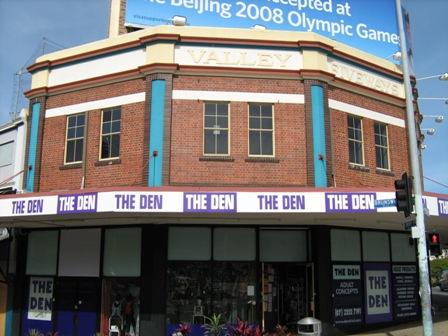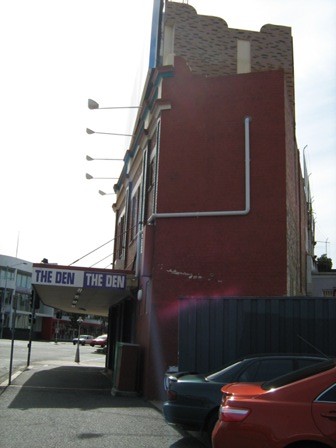Addresses
Type of place
Shop/s
Period
Interwar 1919-1939
Style
Free Classical
Addresses
Type of place
Shop/s
Period
Interwar 1919-1939
Style
Free Classical
This two-storey masonry corner building was constructed circa 1928-29, not long after the construction of Barry Parade created the intersection known as “the Valley Fiveways”. The building provides evidence of the strong commercial growth of the Valley during the 1920s when the Valley rivalled the city as a shopping destination. It also makes an important visual contribution to the historical landscape of this area.
Lot plan
L19_SL11669
Key dates
Local Heritage Place Since —
Date of Citation —
Construction
Walls: Face brickCriterion for listing
(A) Historical; (E) AestheticInteractive mapping
Lot plan
L19_SL11669
Key dates
Local Heritage Place Since —
Date of Citation —
Construction
Walls: Face brickCriterion for listing
(A) Historical; (E) AestheticInteractive mapping
History
This small but imposing corner building was built circa 1928-29 on the newly created intersection that became known as the Valley Fiveways. This was created by the construction of Barry Parade in 1926-27 through the existing crossroads of Brunswick Street and St Paul’s Terrace (formerly Leichardt Street). The building’s prominence as a landmark at this familiar intersection is reflected in the name “Valley Fiveways Building” which is carved into the façade.
The construction of Barry Parade, while a 1923 initiative of the Brisbane City Council under Mayor Diddams, was completed within a couple of years by the Greater Brisbane Council, amalgamated in 1925. The project fell neatly within the plans of the new council for “city improvements” such as the building of permanent arterial roads. When completed, Barry Parade allowed an easier flow of traffic around the commercial heart of Fortitude Valley and into the city. Just over a decade later it would also feed traffic onto the newly built Story Bridge.
The subject site, along with other land along the proposed route, was resumed by the Council by 1925. The new intersection required the demolition of the existing building on the site – a row of four shops – as more than half of the property was to be sacrificed for the new road reserve. The resulting semi-circular site dictated the unusual shape of the new building. This property, measuring less than nine perches, was purchased in April 1927 by John and Basil Mavromattes. The building they constructed was of two storeys, with four shops on the ground floor.
At this time, the Valley was experiencing substantial growth as the prosperity of the 1920s fuelled both a flurry of construction in the Valley heart and the desire of Brisbane residents for the most modern shopping experience. In addition to the construction of a large number of new, usually masonry buildings, many existing premises were altered or extended in an effort to attract business. In 1928, alterations were carried out on the Shamrock Hotel on the opposite corner of the Valley Fiveways by the Brisbane architectural firm of Addison and McDonald, while extensions to the Valley premises of both Overells and Woolworths were overseen by Atkinson, Powell and Conrad in the same year. The showpiece of the Valley – a new five-storey addition to McWhirters – was built in 1930-31 at the exorbitant cost of ₤112 300. This period of renewal altered the streetscapes of the Valley heart and created much of its present historical character.
By the beginning of the 1930s, two of the shops in the new Valley Fiveways Building were tenanted by Madame Molyndux, a dressmaker, and the printing offices of the Valley Press, who soon moved to the adjacent building in at 185 Brunswick Street . The ground floor of the building was leased in 1937 to Peters Arctic Delicacy Co. Ltd, who operated a café on the site and sub let the second shop to John Christie, a fruiterer. A variety of other tenants followed.
The building remained in the ownership of the Mavromattes until the death of Basil Mavromattes in 1970 after which it was sold. In more recent decades, the building has earned a degree of notoriety due to an association with the sex and entertainment industries.
Despite the small size of the site, the Valley Fiveways Building has quite an imposing presence at this intersection and it is not dissimilar in scale to the Shamrock Hotel on the opposite corner.
Description
The Valley Fiveways Building is a two storey brick structure which is somewhat irregular in shape. Its front façade includes a semi-hexagonal section which addresses the intersection while a simpler façade extends south along Barry Parade.
The upper storey features restrained detailing and pairs of paned double hung sash windows in most of the faceted bays, which are separated by moulded face brick and rendered pilasters. The name “Valley Fiveways Building” is carved into the parapet across three of the bays.
A suspended awning over the footpath extends around the length of the building.
Statement of significance
Relevant assessment criteria
This is a place of local heritage significance and meets one or more of the local heritage criteria under the Heritage planning scheme policy of the Brisbane City Plan 2014. It is significant because:
References
-
Brisbane City Council Aerial Photographs
-
Brisbane City Council Water Supply & Sewerage Detail Plans
-
City of Brisbane Digest of Proceedings, 1925-1927
-
Department of Natural Resources, Queensland Certificate of Title records
Citation prepared by — Brisbane City Council (page revised September 2020)


